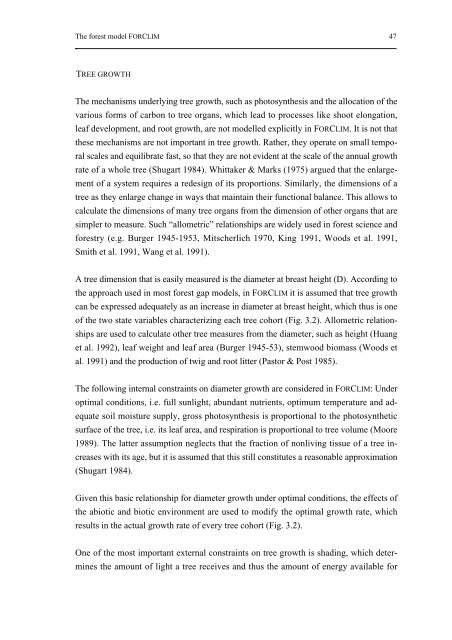On the Ecology of Mountainous Forests in a Changing Climate: A ...
On the Ecology of Mountainous Forests in a Changing Climate: A ...
On the Ecology of Mountainous Forests in a Changing Climate: A ...
You also want an ePaper? Increase the reach of your titles
YUMPU automatically turns print PDFs into web optimized ePapers that Google loves.
The forest model FORCLIM 47<br />
TREE GROWTH<br />
The mechanisms underly<strong>in</strong>g tree growth, such as photosyn<strong>the</strong>sis and <strong>the</strong> allocation <strong>of</strong> <strong>the</strong><br />
various forms <strong>of</strong> carbon to tree organs, which lead to processes like shoot elongation,<br />
leaf development, and root growth, are not modelled explicitly <strong>in</strong> FORCLIM. It is not that<br />
<strong>the</strong>se mechanisms are not important <strong>in</strong> tree growth. Ra<strong>the</strong>r, <strong>the</strong>y operate on small temporal<br />
scales and equilibrate fast, so that <strong>the</strong>y are not evident at <strong>the</strong> scale <strong>of</strong> <strong>the</strong> annual growth<br />
rate <strong>of</strong> a whole tree (Shugart 1984). Whittaker & Marks (1975) argued that <strong>the</strong> enlargement<br />
<strong>of</strong> a system requires a redesign <strong>of</strong> its proportions. Similarly, <strong>the</strong> dimensions <strong>of</strong> a<br />
tree as <strong>the</strong>y enlarge change <strong>in</strong> ways that ma<strong>in</strong>ta<strong>in</strong> <strong>the</strong>ir functional balance. This allows to<br />
calculate <strong>the</strong> dimensions <strong>of</strong> many tree organs from <strong>the</strong> dimension <strong>of</strong> o<strong>the</strong>r organs that are<br />
simpler to measure. Such “allometric” relationships are widely used <strong>in</strong> forest science and<br />
forestry (e.g. Burger 1945-1953, Mitscherlich 1970, K<strong>in</strong>g 1991, Woods et al. 1991,<br />
Smith et al. 1991, Wang et al. 1991).<br />
A tree dimension that is easily measured is <strong>the</strong> diameter at breast height (D). Accord<strong>in</strong>g to<br />
<strong>the</strong> approach used <strong>in</strong> most forest gap models, <strong>in</strong> FORCLIM it is assumed that tree growth<br />
can be expressed adequately as an <strong>in</strong>crease <strong>in</strong> diameter at breast height, which thus is one<br />
<strong>of</strong> <strong>the</strong> two state variables characteriz<strong>in</strong>g each tree cohort (Fig. 3.2). Allometric relationships<br />
are used to calculate o<strong>the</strong>r tree measures from <strong>the</strong> diameter, such as height (Huang<br />
et al. 1992), leaf weight and leaf area (Burger 1945-53), stemwood biomass (Woods et<br />
al. 1991) and <strong>the</strong> production <strong>of</strong> twig and root litter (Pastor & Post 1985).<br />
The follow<strong>in</strong>g <strong>in</strong>ternal constra<strong>in</strong>ts on diameter growth are considered <strong>in</strong> FORCLIM: Under<br />
optimal conditions, i.e. full sunlight, abundant nutrients, optimum temperature and adequate<br />
soil moisture supply, gross photosyn<strong>the</strong>sis is proportional to <strong>the</strong> photosyn<strong>the</strong>tic<br />
surface <strong>of</strong> <strong>the</strong> tree, i.e. its leaf area, and respiration is proportional to tree volume (Moore<br />
1989). The latter assumption neglects that <strong>the</strong> fraction <strong>of</strong> nonliv<strong>in</strong>g tissue <strong>of</strong> a tree <strong>in</strong>creases<br />
with its age, but it is assumed that this still constitutes a reasonable approximation<br />
(Shugart 1984).<br />
Given this basic relationship for diameter growth under optimal conditions, <strong>the</strong> effects <strong>of</strong><br />
<strong>the</strong> abiotic and biotic environment are used to modify <strong>the</strong> optimal growth rate, which<br />
results <strong>in</strong> <strong>the</strong> actual growth rate <strong>of</strong> every tree cohort (Fig. 3.2).<br />
<strong>On</strong>e <strong>of</strong> <strong>the</strong> most important external constra<strong>in</strong>ts on tree growth is shad<strong>in</strong>g, which determ<strong>in</strong>es<br />
<strong>the</strong> amount <strong>of</strong> light a tree receives and thus <strong>the</strong> amount <strong>of</strong> energy available for















